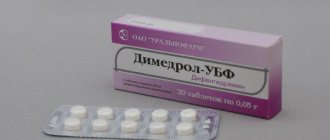Egg whites. An effective solution after alcohol abuse. The whites of three eggs must be beaten and immediately drunk in one gulp. Ammonia. To get rid of signs of nausea and vomiting, use ammonia dissolved in water (10 drops per half glass of water) every 20 minutes. Ammonia can be replaced with apple cider vinegar. Elecampane for severe poisoning. Take 2 tbsp per glass of boiling water. grated elecampane root and leave for 20 minutes. Drink 1 tbsp. 2-3 times a day before meals. We repeat that any non-traditional remedy should be used only with the prior approval of the attending physician. Self-medication can do more harm than good and will only worsen the patient’s condition.
What disease may constant vomiting indicate?
There are various groups of diseases that occur with constant vomiting. Depending on the nature of its occurrence and characteristics, the disease is diagnosed:
Central vomiting – meningitis, migraine, hypertensive crisis, encephalitis, glaucoma, brain tumors and abscess, damage to the inner ear;
Psychogenic vomiting – hysterical neurosis, anorexia, attacks of cyclic vomiting in children;
Hematogenous-toxic vomiting - uremia, acetonemic vomiting in diabetes mellitus, porphyria, carbon monoxide poisoning, alcohol, drugs, cytostatics, radiocontrast agents, exposure to viral and bacterial toxins in infectious lesions;
Visceral vomiting – pathologies of the gastrointestinal tract (gastritis, peptic ulcer, duodenitis), diseases of the biliary and urinary tracts, acute appendicitis, pyloric stenosis, atony and gastric paresis;
Vomiting with a putrid odor – stomach cancer;
Vomiting with a fecal odor – intestinal obstruction;
Vomiting with bile – complications after surgery on the stomach, biliary colic, narrowing of the duodenum;
Vomiting with undigested food - gastric achylia, achalasia of the esophagus.
To clarify the diagnosis, a bacteriological, chemical, cytological study of vomit is carried out, the relationship of vomiting with food intake is studied (morning, early, late, fasting, night and cyclic vomiting).
Prohibited events
Often unexpectedly detected by parents, vomiting in a child without fever or diarrhea baffles them.
It is prohibited to carry out the following procedures yourself:
- rinse the stomach when the baby is unconscious;
- give the child any antiemetic or antispasmodic drugs;
- use antiseptics to cleanse the stomach;
- introduce antibacterial agents into treatment;
- ignore visiting the pediatrician again after you feel better and symptoms disappear.
Why might there be water vomiting?
This type of vomiting is extremely rare, except for artificially induced vomiting during gastric lavage.
Causes of water vomiting in children:
Pathologies of the ear, nose and throat.
All these reasons are due to large amounts of mucus entering the stomach. It flows from the nasal and oral cavities through the throat and esophagus into the stomach. Irritation of its mucous membrane causes vomiting. The consequence of this is vomiting of water without impurities.
In the absence of visible causes of the disease, this symptom manifests itself due to excessive dry air, exposure to air in frosty weather, and also due to an allergic reaction. In this case, the release of a large volume of mucus is the body’s protective reaction to the negative influence of the environment. Then everything happens according to the algorithm described above - the mucus irritates the gastric mucosa, where it enters in excess quantities.
It is not difficult to eliminate this symptom in children; you need to create optimal living conditions and cure the pathology of the ENT organs.
If vomiting water is diagnosed in an adult, this may be due to long breaks between meals. Gastric juice is secreted reflexively, and the longer the interval between meals, the more juice is formed in the stomach. If a large amount of juice causes vomiting, it may seem like you are vomiting water. Visually, these liquids are almost indistinguishable from each other.
For various reasons, a person does not feel that he is hungry, however, the body needs food. This condition leads to excessive production of stomach acid and vomiting that looks like water.
Application of liquids
When a person is not sick and everything is in good health, then inducing a gag reflex can be very problematic. It depends on the amount you drink and eat. Solutions help speed up the process if made correctly.
Water, tea and potassium permanganate
Water serves as the main way to dilute harmful substances that accumulate in the stomach. Thanks to fluid, the body gets rid of toxins. In order for vomiting to occur, a lot of water should be taken in one gulp. Sometimes two glasses are enough. After a few minutes, nausea sets in, followed by a gag reflex. If you fail to vomit, you need to press the far tip of your tongue with your fingers.
Clean water can be replaced with regular black tea. If you add milk to it, you get a tasty drink, and if you also add salt, then the gag reflex will set in quickly. In total you will have to use 2-3 cups of this specific tea. However, you should not add too much salt. The taste should be tolerable: 1 tbsp is enough. l.
Potassium permanganate is used as a remedy for intoxication of the body. This is a proven recipe that is suitable for both adults and children. Potassium permanganate can cleanse the body through vomiting. This remedy must be used carefully so as not to burn the palate, as well as the stomach and esophagus.
The color of the solution should be barely pink: add a few crystals to a glass of water and stir. You will get a saturated solution, wait a minute for the undissolved crystals to settle to the bottom, and then pour the contents from the glass into another glass and add water. Now you can drink the product. Sometimes one glass is not enough to induce vomiting. Then you should drink more.
Soda solution or herbal decoction
Soda solution is a reliable, proven method. To prepare it you only need baking soda and water. This remedy helps in the fight against excess weight. People who tend to overeat and can't stop themselves from eating too much can try a baking soda solution. The effect of this drink will not take long to appear. The product quite successfully neutralizes harmful substances. Cleansing is carried out 3 days in a row after meals in the daytime. On the third day, the soda solution should be replaced with plain water.
Read also How to take a stool test for disgroup
In order to develop a gag reflex, you need to follow the following sequence of actions:
- Dissolve soda in water.
- Drink the contents as quickly as possible. Try to keep the solution inside for a few minutes. Your back should be kept straight. You need to drink the product until you ask for it back.
- When you feel nausea creeping in, you should press your fingers on the base of your tongue and at the same time stroke your stomach clockwise. After everything comes out, the urge will stop.
To induce nausea, you can use some herbs in the form of decoctions or infusions. A tincture of calamus root can make you vomit. Before cooking, the herb is steamed with hot water and infused for 3-4 hours. To induce vomiting you will need to drink about 1 liter of infusion.
Can there be vomiting with mucus and why?
An admixture of mucus occurs in many pathologies in both children and adults. Diseases for which vomiting with mucus is diagnosed:
Dietary disorders in chronic gastritis;
Damage to the mucous membrane by alkalis or acids (suicide attempt, accident).
Vomiting with mucus in infants is normal. However, in this age category, such vomiting may be the result of an accumulation of mucus due to inflammation of the bronchi. An infant cannot cough it up due to his age. When children consume foods of a special consistency (milk, jelly, fruit juices with pulp), vomiting with mucus is also observed.
Can there be black vomit and is it dangerous?
Black vomiting may be a sign of a serious pathology or have a physiological cause. Some foods turn vomiting black: chocolate, berries with dark pulp, etc. Knowing about their consumption on the eve of vomiting, you can only focus on relieving this unpleasant symptom.
Vomiting in the form of “coffee grounds” is a great danger. It indicates bleeding in the stomach or duodenum. The peculiar appearance of the blood indicates that it has oxidized and coagulated under the influence of gastric juice.
Diseases that cause bleeding in the gastrointestinal tract:
Neoplasms of any etiology (tumors, polyps);
Trauma to the mucous membrane of the stomach or intestines;
Ulcerative lesions of the stomach or small intestine;
Side effects of drugs that can cause damage to the stomach or intestines (Indomethacin, Aspirin, Ibuprofen, drugs, steroid hormones);
Stomach or intestinal bleeding is accompanied by dizziness and weakness. The patient's skin becomes pale, a feeling of apathy appears, and the person may faint. These symptoms are a reason to immediately call an ambulance, as delay can be life-threatening. If black vomit is the only symptom, you should still see a doctor as soon as possible.
What disease can cause a temperature of 38 and vomiting?
Diseases in which there is a combination of vomiting and high fever:
Acute respiratory viral infection;
In the vast majority of cases, these symptoms are observed precisely during gastrointestinal infections. Children may react by vomiting to a rapid increase in temperature during any inflammatory process.
The initial manifestations of an intestinal infection and a viral disease are very similar: in both cases, hyperthermia, redness of the throat, and vomiting are observed. Specific symptoms appear a little later.
Can antibiotics cause vomiting?
Antibiotic drugs have a large number of side effects, and vomiting occurs when using these drugs along with other symptoms.
Causes of vomiting while taking antibiotics:
Vomiting is a side effect of a specific drug;
There is incompatibility of the antibiotic with concomitantly taken medications from other pharmacological groups;
Dietary disturbances or alcohol consumption occurred during antibiotic therapy.
The occurrence of vomiting directly depends on the form in which the drug is taken. Antibiotics in tablet form are more likely to cause vomiting than the same drugs given in injection form. You should not refuse a particular medication if oral use causes vomiting. It is worth trying intravenous or intramuscular administration. Adjusting the dosage to reduce the volume or frequency of taking the medication will reduce the risk of this unpleasant side effect, but at the same time the effectiveness of the treatment may suffer.
Antibiotics that may cause vomiting:
Ciprofloxacin (Tsiprobay, Tsiprinol, Tsiprolet);
Vomiting is often a reaction following nausea. Both of them are a protective phenomenon of the body against the ingress of harmful substances. In addition, vomiting may indicate the presence of serious illnesses.
Features of vomiting
As mentioned above, vomiting is mainly a protective reflex, so it can be extremely difficult to avoid. The body believes that harmful substances have arrived and seeks to get rid of them. Moreover, harmful substances into the blood may not always come from the gastrointestinal tract.
Interestingly, women vomit more often than men.
At the same time, children are most susceptible to this unpleasant process. Vomiting is not necessarily a symptom of any disease; it can also be a consequence of toxicosis in pregnant women, and a reaction to fear or other negative emotions, poisoning, irritation of the peritoneum, or the accumulation of toxic metabolic products in the blood.
What factors affect folic acid?
- The more foods are processed thermally, the worse their situation with vitamin B9:
- if the meat is fried, only 5% of folic acid remains in the original product,
- in boiled vegetables and meat remains from 10 to 30%,
- Boiled eggs contain only half of vitamin B9.
- Estrogens can neutralize folates.
- Modern medicines for ulcers (helping to neutralize hydrochloric acid), aspirin in large doses, drugs that contain alcohol and drugs that lower cholesterol and harmful fats in the blood, contraceptives (oral), anticonvulsants, antimicrobials (sulfonamides) and antitumor pharmaceuticals (antimetabolites) disrupt the absorption of folic acid.
Vomiting can be a symptom of illness
By paying attention to the nature and frequency of vomiting, you can draw superficial conclusions about the reasons for its occurrence. Thus, in infectious diseases, the gag reflex precedes diarrhea and is accompanied by weakness and fever. After such vomiting, the patient does not feel relief. Vomiting blood may indicate bleeding from the stomach or duodenum. If there is also an admixture of foam, this indicates pulmonary hemorrhage. Vomiting water occurs rarely; as a rule, it is observed in children during teething, acute respiratory viral infections, and diseases of the respiratory tract and ENT organs. Vomiting water is not particularly dangerous.
Testing of the vestibular apparatus
Sometimes the body's abilities can be used to trigger the gag reflex. For some people, traveling in public transport is a complete disaster because they get motion sickness. For such “lucky” people, the method will be effective, and vomiting will not be difficult.
It’s enough just to spin around the room quickly and quickly. To enhance the effect, you should combine your dance with head rotations; it is not necessary to do it clockwise. All movements should be ill-considered and chaotic. You can add slopes. A person who needs to vomit at any cost can remember his childhood and go on a swing. It is advisable that they be close to home.
Read also Food poisoning during pregnancy: main signs and symptoms
Why does water vomit occur?
In children, vomiting water is a consequence of colds or the process of teething. It occurs due to the formation of a large amount of mucus, which flows down the throat and irritates the mucous membranes. This irritation causes vomiting. By the way, mucus can also form due to allergies or dry air. In adults, this type of vomiting can occur with long gaps between meals. The gastric juice produced irritates the mucous membrane and causes vomiting. This happens when the intervals between meals regularly reach 10-12 hours. Moreover, one interval per day is enough. For example, a person has dinner at 18.00 and breakfast at 6.00. It is during this period that vomiting of water can occur.
How to get rid of vomiting
It’s easy to get rid of vomiting with water - the child needs to create suitable conditions, humidity levels, and cure the cold. An adult needs to normalize their diet by making intervals between meals no more than 8 hours. If vomiting of another type continues for a long time or has impurities, this is a reason to urgently consult a doctor. And as first aid, you need to rinse your stomach by drinking about 2 liters of boiled water and several tablets of activated carbon at the rate of 1 tablet per 10 kg of weight.
Finally, a video on the topic:
Noticed a mistake? Select it and press Ctrl+Enter to let us know.
Liked? Like and save on your page!
Nausea and vomiting in an adult are protective phenomena that are not amenable to a person’s conscious control. The processes feel similar and often accompany each other. The defense mechanism is designed to rid us of harmful substances. But attacks of vomiting can occur even if the stomach is not in danger. Many people literally feel sick from smells or sounds.
Folk remedies
Alternative medicine methods for nausea and headaches can only be used in consultation with a doctor. Self-medication is contraindicated if the following symptoms appear:
- profuse, continuous vomiting;
- the presence of bloody inclusions in the vomit;
- temperature rise to critical levels;
- loss of consciousness.
If an adult or child has a stomach ache and nausea as a result of food poisoning, chamomile infusion, which can be prepared according to the following recipe, will help alleviate the condition:
Folk remedies for nausea
- Boil 200 ml of water and pour it into 2 tbsp. l. dried chamomile flowers.
- Infuse the product for 10 – 15 minutes, then strain and dilute with 100 ml of boiled water.
- Cool the finished infusion to room temperature, add a spoonful of honey and try to drink in small portions throughout the day. This drink will relieve irritation and spasms, and also prevent dehydration in case of frequent vomiting.
If a person feels more nauseous in the evenings and is also bothered by heaviness in the stomach due to problems associated with digestion, fresh potato juice, which is recommended to be taken 4 to 5 times a day, 1 teaspoon, will help relieve the condition. The useful remedy is prepared as follows:
- Peel a medium-sized potato and grate it on a fine grater.
- Place the cake in cheesecloth, folded into a widow, and squeeze out all the juice.
- Store the liquid in the refrigerator in a glass container.
If nausea is accompanied by a headache, a decoction of coriander will help relieve the pathological syndrome. The recipe is simple:
- Boil 250 ml of water, then add 1 tsp. coriander seeds.
- Let the liquid boil, then add ½ tsp. tea leaves.
- Remove the container from the heat and let it brew for 10 - 15 minutes.
- Drink the entire broth in small sips.
An attack of nausea and headache will subside if you drink warm water with a small amount of lemon juice and a spoonful of fresh honey. Another useful recipe for an unpleasant symptom is a decoction of ginger root:
- Finely chop the root with a knife, then take 1 tsp. ingredient and pour into boiling water - 200 ml.
- Boil the product for 5 – 7 minutes, then cool and add a spoonful of honey.
Common Causes of Vomiting
Nausea from strong odors of perfume, raw meat, fish or cooked food is a frequent companion of pregnant women. And if this is not pregnancy, then what? Then you should contact a gastroenterologist, endocrinologist, therapist or neurologist for advice.
Causes of vomiting due to odors can be:
- hunger - this is how the stomach reminds you that breakfast and lunch should be on schedule, it is advisable to have a full breakfast before traveling on stuffy public transport;
- chronic gastrointestinal diseases;
- nervous overstrain - neuroses, stress, depression;
- allergies or poisoning.
Unpleasant sounds such as the sound of vomiting, scratching with a knife on a plate, the sound of a microphone malfunction with prolonged exposure also provoke vomiting. An unpleasant sight often causes nausea. Such a reaction indicates excessive impressionability, and sometimes even the first stages of neurosis.
Nausea against the background of non-existent odors. When it seems like it smells like burning or something else, it may indicate brain tumors.
Many people live and cope with nausea on their own, without paying much attention and without thinking about the real reasons. Although sometimes this is the only early sign of heart problems, ear infections and other hidden inflammatory processes.
Prevention
The best prevention for nausea and headaches is to identify and treat their causes. Therefore, if a symptom bothers you regularly, it is better not to postpone a visit to the doctor. Once the source of both syndromes is eliminated, they will disappear on their own, without special treatment.
If attacks of nausea and headaches are caused by factors such as stress, nervous overload, psycho-emotional stress, depression, in such situations doctors advise following simple rules of prevention:
- establish a daily routine;
- try to fully rest and get enough sleep;
- learn to respond adequately to stress and unpleasant situations;
- walk more in the fresh air;
- add moderate physical activity;
- adjust your diet;
- stop drinking alcoholic beverages, coffee, strong tea, quit smoking;
- have dinner no later than 3–4 hours before bedtime;
- harden yourself and keep your immune system in good condition.
Nausea during inflammatory processes
Nausea and vomiting combined with dizziness and loss of balance are symptoms of ear inflammation. It occurs as a complication after influenza, otitis media, measles, tuberculosis, meningitis, scarlet fever and other infectious diseases.
Labyrinthitis is an inflammation of the inner ear, which has the shape of a labyrinth filled with endolymph. Not only are auditory analyzers located here, but also vestibular receptors are located in the tubules, which are responsible for orienting the body in space, balance and coordination. Inflammatory processes affect both functions, which provokes such symptoms.
Most often observed 1-2 weeks after otitis media. The middle ear is separated from the inner ear by a membrane. When inflamed, the wall swells and becomes permeable. Toxins and pathogens penetrate deeper, and purulent labyrinthitis occurs.
The following symptoms may be observed:
- heavy sweating;
- temperature;
- pallor;
- hyperemia of the facial skin - strong blush;
- tachycardia;
- discomfort in the heart area;
- noise in ears;
- hearing loss;
- nystagmus - a feeling that everything around you is spinning.
How to stop vomiting? With such symptoms, it is unwise to try to cope with the condition on your own. Before the ambulance arrives, the patient must be hydrated with special solutions to reduce dehydration. Further treatment will be aimed at eliminating inflammation. Antiemetic drugs may be used. Self-administration of such medications is undesirable.
Nausea from water: causes, what to do and preventive measures
Tap water is poisoned by pathogenic microorganisms, which causes nausea and increases the risk of ascariasis, botulism, anemia, cholera, cambilobacteriosis, fever and other dangerous ailments.
But drinking boiled water does not guarantee the absence of harm to health: during heat treatment, the chlorine contained in the water reacts with organic compounds. Toxic trigahometals are formed in the water, and the liquid loses oxygen.
If you regularly experience nausea after drinking water, you should immediately consult a doctor.
Causes
The etiology of nausea after a glass of water has a pathological basis. An increased concentration of phenols, petroleum products, pesticides, and certain chemical components in H2O (iron, chlorine, sodium, potassium) can seriously harm the functioning of internal organs.
Women in the first trimester of pregnancy systematically experience epigastric discomfort after drinking a glass of water. This symptom in expectant mothers is not a cause for concern: hormonal changes in the body are accompanied by pronounced nausea.
Pathologies
There is a wide range of disorders that manifest as discomfort in the epigastric region after drinking water. These include:
- respiratory infections (flu, adenoviral disease);
- ailments of the ENT organs (diphtheria, rhinitis);
- diseases of the digestive tract (stomach ulcer, intestinal helminthiasis);
- infections affecting the central nervous system (acute myelitis, encephalitis, viral meningitis);
- dysfunction of the vestibular apparatus (motion sickness in transport);
- pathologies of the vascular system (anemia, hyper/hypotension).
Important! People working in hazardous industries are at increased risk.
In zones of environmental disasters, water contains toxic chemical compounds and salts of heavy metals, which, when ingested, can provoke a whole set of painful symptoms in the form of: nausea, vomiting, headache (cephalalgia), hyperthermia (increased body temperature) and malaise.
Food intoxication
After eating low-quality (expired) food products, there is a huge likelihood of discomfort in the epigastric region and accompanying symptoms characteristic of food intoxication (fever, loose stools, weakness, cephalgia). Once in the stomach, pathogenic microorganisms (staphylococci, streptococci, E. coli, salmonella) produce cytotoxins that damage the mucous membrane of the digestive tract. The patient is dehydrated, mucus and leukocytes are present in the stool, diarrhea is accompanied by bloody discharge. Poisoning with counterfeit products may not be of an inflammatory nature, when pathogenic bacteria do not penetrate the walls of the small intestine. But under the influence of enterotoxins, the organ mucosa is damaged.
It is important for the victim to drink plenty of fluids and limit food intake for 4-5 hours to eliminate the possibility of repeated attacks of nausea/vomiting.
Side effect of pharmacological agents
Each medicine created by pharmacists has a certain set of negative health effects that are not related to its direct purpose.
Certain components included in the drug may be allergenic for individual categories of patients. The body reacts to them with discomfort in the epigastric region and a subsequent gag reflex.
To mitigate the risk of intolerance to the components in a particular drug, you should abandon it and choose an analogue on the recommendation of a doctor.
Pregnancy
Discomfort in the epigastric region can bother the expectant mother at any stage of pregnancy.
In the first weeks of gestation, nausea indicates the fertilization of the egg and its attachment to the uterine mucosa.
As the embryo develops, the concentration of hormones in a woman’s blood increases - progesterone, estrogen and human chorionic gonadotropin. The body reacts to these changes with nausea and vomiting.
The cause of discomfort in the epigastric region may be a hereditary predisposition. Nervous tension and a stressful situation are additional risk factors for the occurrence of unpleasant sensations in the epigastrium. Lack of blood sugar, bad habits and complications of gastrointestinal diseases also provoke the manifestation of an unpleasant symptom in the body of a pregnant woman.
Increased intracranial pressure
Intracranial hypertension is characterized by insufficient blood circulation and increased concentration of cerebrospinal fluid in the structures of the brain.
Various factors can provoke pathology: mechanical damage (bruises) to the brain, diseases of the central nervous system (meningitis, epilepsy, encephalitis), malignant tumors, impaired tone of blood vessels, excess body weight.
The patient experiences a severe headache that is not relieved by analgesics, chills, sweating, increased salivation, colic in the heart, shortness of breath, nausea and vomiting.
Activation of the reflex occurs due to increased pressure on the nerve endings of the vomiting center, localized in the medulla oblongata. The process of gastric emptying in intracranial hypertension and migraine is different: in the first case, there is profuse (gushing) vomiting that does not stop for a long time.
Symptoms
Discomfort in the epigastric region that occurs after drinking water may be accompanied by alternative signs indicating the presence of malfunctions and problems in the body. These include:
- heart rhythm disturbance;
- confusion;
- diarrhea;
- vomit;
- malaise (lethargy);
- apathy;
- convulsions;
- swelling of the limbs.
Important! If a patient drinks a large volume of liquid (3 or more liters) in a short period of time (1 hour), there is a risk of death from pulmonary or cerebral edema.
What to do
There are situations in which nausea should be taken as a signal to immediately call an ambulance. You need to call number “03” if:
- epigastric discomfort does not stop for a long time (a day or more);
- the structure of the vomit contains particles of bile or blood;
- the gag reflex is accompanied by hyperthermia, convulsions, chills;
- unpleasant sensations in the epigastric region are accompanied by headaches and colic in the abdominal cavity.
If several pathological signs appear, it is necessary to establish the root cause of the disease through the use of diagnostic procedures in a hospital setting.
First aid
An attack of nausea can transform into the process of emptying the stomach, which can lead to dehydration. To minimize the likelihood of complications after a gag reflex, you should adhere to certain recommendations:
- refusal of physical activity (with bed rest, muscle spasms and headaches weaken; in order to prevent aspiration (penetration of vomit into the respiratory tract), it is necessary to lie on your side);
- it is important to ensure access to fresh air in the room where the patient is located;
- after the act of emptying the stomach, you should rinse your mouth with water and give the patient an enterosorbent agent (Activated Charcoal, Polysorb).
When the gag reflex has subsided, it is not recommended to eat food. You can only drink water or a decoction of medicinal herbs.
After 4-5 hours, you are allowed to eat dietary meat (chicken, turkey), boiled fish, low-fat kefir/yogurt, and cookies.
It is important to monitor the amount of food eaten: small portions, chewing food thoroughly, the absence of external factors (talking, reading newspapers, watching TV during a meal) are the key to successful digestion.
Drug therapy
After the gastric lavage procedure, the doctor at the initial stage of treatment stops the effects of vomiting and restores the water and electrolyte balance (Regidron, Gidrovit solution). Further treatment depends on the root cause of the pathology, manifested by discomfort in the epigastrium.
If nausea is a consequence of gastrointestinal pathologies, then the following are recommended: Buscopan, Cisaprite, Bonin.
When the source of discomfort in the epigastric region is dysfunction of the vestibular apparatus, the following are prescribed: “Ciel”, “Dimenhydrinate”.
Epigastric discomfort caused by chemotherapy is eliminated with the help of Setronon, Emetron, Ondansetron.
An unpleasant symptom that appears due to nervous tension or stressful situations can be relieved with Relanium and Prazepam.
Nausea, which is activated after the penetration of pathogenic bacteria and viruses into the body, is eliminated by Nifuraxazide, Furozolidone, and Enterofuril.
Discomfort in the epigastric region caused by toxicosis in pregnant women is eliminated by “Hofitol” and “Cocculin”.
Important! The prescription of medications is carried out by a doctor, taking into account the individual characteristics and health status of the patient.
ethnoscience
Herbal medicine helps eliminate nausea after drinking water. The list of “folk” recipes includes:
- chicory decoction (10 g of dried plant is poured into 0.3 liters of boiling water, the drink is left overnight and filtered, take: 30 ml half an hour before meals);
- decoction of water trefoil/trifol (10 g of the plant is added to 0.5 liters of cool water, the preparation is infused for 8-10 hours and filtered, take: 3 times a day, 50 ml);
- infusion of lingonberries and cranberries (a mixture of plants in the amount of 300 g is brewed in 0.7 liters of boiling water, the drink is left for 2 hours and filtered, take: 5-6 times a day, 50 ml);
- chamomile mixture (60-70 g of the plant is added to 1 liter of fresh cream, the preparation is subjected to heat treatment, brought to a boil, after five 5 minutes remove from heat and leave for 1-1.5 hours, take: 200 ml after meals;
- a decoction of medicinal herbs (5 g of St. John's wort, 5 g of chamomile, 5 g of plantain, 5 g of peppermint are mixed and brewed in 1 liter of boiling water, the drink is infused for 30-40 minutes and filtered, take: 30 ml every hour).
Before using a specific herbal medicine recipe, consultation with a doctor is required to eliminate the risk of allergic reactions to certain plants/herbs and contraindications for certain categories of patients.
Recommendations
You can reduce the likelihood of worsening nausea after drinking water if you follow certain recommendations.
It is necessary to drink 1 glass of boiled water before breakfast. You should give up the habit of quenching your thirst with raw water, which may contain pathogenic microorganisms.
Preference should be given to filtered liquid that has been processed by the sorption method in combination with the method of ultraviolet sterilization. To make drinking easier, it is recommended to add a few drops of lemon juice to a glass of water.
It is necessary to carefully monitor your diet: it makes sense to give up fatty, fried, salty, smoked foods, carbonated drinks and give preference to steamed/boiled dishes.
It is important to lead a healthy lifestyle, not abuse bad habits and, for preventive purposes, undergo an annual medical examination by specialized doctors (neurologist, therapist, cardiologist, gastroenterologist, immunologist).
Source: https://izjoga.info/toshnota-i-rvota/ot-vody-prichiny-chto-delat.html
Painful nausea without fever or diarrhea
Heart problems are often accompanied by nausea and vomiting. Violation of the pumping function of the heart muscle, in addition to nausea, is manifested by flatulence, constipation and other dispersive symptoms. Hypoxia leads to this reaction in the body. There is not enough oxygen in the tissues of the digestive system. Structural changes in the muscle fibers of the myocardium lead to tissue swelling in the abdominal and thoracic region. Weakness of the heart often provokes vomiting as a side effect of medications.
Myocardial infarction may be preceded by painful nausea and vomiting for another 5 days. And also the change of high blood pressure and tachycardia by a sharp drop in pressure. Shortness of breath, unreasonable fear and acute pain in the chest intensify.
The so-called “gastric” or abdominal infarction is disguised as gastrointestinal problems. Symptoms:
- cutting pain in the epigastric region;
- nausea;
- urge to vomit;
- pain appears in the stomach area and increases rapidly, as with an ulcer or gastritis.
Important! Vomiting does not provide relief. Typically, the patient previously complained of angina. Pain and vomiting occur regardless of food intake. Such differences make it possible to exclude inflammation of the gastric mucosa.
More often, the weaker sex is susceptible to such attacks, since the diaphragm is located slightly higher than in men and the lower part of the heart is located closer to the stomach. Typical signs of a heart attack are: burning pain, numbness of the limbs, pain in the shoulder, shoulder blade or jaw. But asymptomatic attacks are not uncommon; sometimes nausea and vomiting for no particular reason become the only symptoms.
What disorders does nausea indicate?
A common reason why a person feels sick in the morning is stagnation of bile and its reflux into the stomach. At night, the gallbladder produces a secretion that can penetrate the stomach, irritating it. Therefore, with diseases of the biliary system, one often feels sick in the morning and experiences discomfort in the epigastric area.
If a person constantly feels nauseous after eating, perhaps he often eats hard-to-digest, fatty, spicy foods that irritate the walls of the stomach. Other causes of nausea after eating food:
- pathologies of the biliary tract;
- doudenogastric reflux;
- stomach or duodenal ulcer;
- pancreatitis;
- inflammation of the pancreas;
- gastritis;
- gastrodoudenitis
Nausea in the evening can be caused by psycho-emotional overload, stress, fatigue and exhaustion. People who are used to dining on heavy, fatty, fried foods feel sick in the evenings. In this case, the stomach also hurts and profuse belching bothers you. This is due to the fact that metabolism slows down in the evening. To avoid discomfort after eating in the evening, it is advisable to have a light meal that will be quickly digested and at the same time saturate the body with all the necessary substances.
If a child feels nauseous after eating and is bothered by pain in the navel area, he may develop intestinal dysfunction and dysbiosis. Other common causes of nausea in children:
- binge eating;
- overheat;
- motion sickness in transport
- food poisoning;
- acute respiratory infections, ARVI;
- intestinal infection;
- tick-borne encephalitis;
- foreign object.
If nausea and vomiting occur after hitting your head, this may indicate a concussion. In this case, it is necessary to show the baby to a doctor to prevent the development of serious complications.
Endocrine diseases and possible causes of vomiting
The endocrine system is a complex mechanism of glands that are responsible for the functioning of all organs. Some failures also include vomiting and nausea. The most common ailments are described below.
Vomiting in diabetes is a common symptom, and sometimes the only early sign of problems with glucose. Negligence towards one's health forces one to ignore symptoms. And treating gastrointestinal disorders at home seems to be an acceptable measure.
Diabetes occurs when the pancreas does not secrete enough of the hormone insulin. Improper metabolism of glucose in the body often causes vomiting, since breakdown products are not completely eliminated and accumulate. The concentration of acetone in the plasma increases. A person needs urgent help.
Deterioration of the condition occurs due to an increase or sharp decrease in blood sugar. The reasons for such fluctuations are as follows:
- the patient did not adhere to the insulin administration schedule;
- self-medication with drugs to control insulin in the blood;
- hypoglycemia – a condition when blood sugar is less than normal;
- a condition close to diabetes mellitus, without proper therapy the disease will continue to progress;
- gastroparesis is a violation of gastric motility, the organ has lost the ability to contract properly and food is retained for a long time.
Any fluctuation in blood glucose levels results in nausea. Hyperglycemia is a high level of sugar that also provokes lightheadedness, pain in the chest on the left, and decreased visual acuity. Low glucose levels can lead to brain swelling. Then the vomiting center is under significant pressure, which provokes nausea. The patient also complains of weakness, cramps, and excessive hunger.
Important! Glucose levels can also decrease in a healthy person due to fasting, a strict diet, or prolonged overwork.
Ketoacedosis – insulin deficiency causes cells to draw energy from fat stores. Which in turn leads to an increase in the concentration of ketone bodies in the blood. Intoxication causes nausea. A clear sign is the characteristic smell of acetone from the mouth.
Diabetes insipidus is a disease associated with an imbalance in the body's water balance and is caused by a lack of antidiuretic hormone (ADH). There are three mechanisms for the formation of pathology:
- central – the hypothalamus releases an insufficient amount of the hormone;
- dyspogenic - can also occur with normal hormonal background, the cause is the influence of irritating factors (tumor, surgery) on the thirst centers;
- nephrogenic - kidney tissue becomes resistant to the hormone.
Features of the function of folic acid during pregnancy and not only
- Vitamin B9 is a water-soluble vitamin; its role is extremely high in the formation of the circulatory and immune systems. This is especially important for the unborn child.
- In the process of placenta formation, vitamin B9 also plays a significant role.
- When there is a risk of premature birth or a possible miscarriage, doctors always prescribe folates as part of pharmaceutical preparations (a general group of folic acid derivatives).
- The appearance of a cleft lip and cleft palate in a baby is possible due to a deficiency of vitamin B9 in his mother during pregnancy.
- A lack of folic acid in a woman’s body can cause placental abruption.
- Due to a lack of this vitamin, a child’s mental development may be delayed, the appearance of dropsy of the brain, even its complete absence, and in extreme cases, the birth of a stillborn baby.
- Folic acid is needed both during pregnancy and during breastfeeding, because the processes of growth and formation of the child’s body do not stop.
- The use of vitamin B9 can be an excellent protection for a woman against postpartum depression.
- For men, a sufficient amount of vitamin B9 in the body helps improve sperm quality and increase sperm count.
- This substance is also necessary for the proper functioning of the liver and intestinal tract.
- The normal course of redox processes in the body is impossible without vitamin B9.
- In order for white blood cells to function properly, the body must have enough folic acid.
The peak “need” for folic acid occurs before the child is conceived and in the first 28 days after. The fact is that from 16 to 28 days after conception, the formation of the fetal neural tube occurs.
After 12 weeks of pregnancy, a woman is recommended to take complexes containing multivitamins, which include folic acid as one of the components. The dosage of vitamin B9 in these preparations is often 0.8 mg (800 µg). This dosage is prophylactic; it can protect against the occurrence of disorders in the development of the embryo.
So, how and in what quantities should you take folic acid?
- When planning pregnancy, as well as during its process, the dosage is 0.4-0.8 mg (400-800 µg) of vitamin B9 (your doctor will tell you the exact dose). There is no need to take breaks.
- For a woman who has previously given birth to a child with developmental disorders or someone in her family who has had this problem, the dosage will be 4 mg per day.
- Increased dosages of vitamin B9 are necessary for women diagnosed with diabetes mellitus or epilepsy, since these problems can also cause the formation of neural tube defects in the fetus.
- A breastfeeding mother needs 0.4-0.6 mg (400-600 µg) of vitamin B9 per day.
- Infants up to one year - 0.05 mg (50 µg).
- Children from one to three years old – 0.07 mg (70 µg).
- Children from three to six – 0.1 mg (100 µg).
- Children from six to ten years old – 0.15 mg (150 µg).
- Adults and children over eleven years of age need 0.4 mg (400 µg) of folic acid per day.
What medications to treat vomiting during motion sickness
Almost 70% of all travelers experienced motion sickness, at least in childhood. 20% of adults never outgrow this problem as they age. In doctors' offices this condition is called kinetosis. It is provoked by the reaction of the vestibular apparatus. Special receptors analyze the position of the head and the movement of the body in space. Sharp turns of the head are an irritating factor; the body reacts with a reflexive contraction of muscles to maintain balance.
A person suffering from kinetosis has a particularly difficult time with sharp turns, ascents/descents, braking/acceleration, airplane takeoff/landing, turbulence, and rocking on the waves while traveling by water. There are people who cannot tolerate all forms of transportation, and for some, there are acceptable travel options.
What should those who are prone to motion sickness do? The recommendations are simple:
- eat an hour or an hour and a half before the trip;
- food should be light and satisfying: boiled chicken or buckwheat porridge;
- give up sweets, carbonated drinks and dairy products;
- you need to sit down in the direction of travel;
- It’s easier to endure the trip if you fall asleep or look straight ahead into the distance;
- It is not recommended to read while driving; it is better to listen to music or an audiobook;
- take special medications for motion sickness.
Medicines for motion sickness and seasickness:
Experts consider the statement “outgrow” to be incorrect. Motion sickness may indicate arterial nutritional disorders. The cerebellum, inner ear, eyes, receptors responsible for contraction of muscles and ligaments, the thalamus and a number of brain centers are responsible for vestibular functions.
The above areas are supplied with blood mainly by the branches of the vertebral artery. Insufficient blood flow can result from birth injuries, including cesarean section, and others. Displacement of bones even by a fraction of a millimeter during childbirth significantly impedes blood circulation. If such an injury occurs, then the vertebral arteries are the first to be compressed. With a high degree of probability, such a child will get motion sickness in transport.
As you get older, motion sickness goes away or is tolerated much easier. This doesn't mean the problem has gone away. The brain just functions better as it gets older. But childhood trauma can manifest itself in other ways. Motion sickness can also be a consequence of a severe head injury or concussion in early childhood.
Motion sickness combined with dizziness is a reason to consult an osteopath. Children respond better to treatment. But adults shouldn’t ignore this problem either.
Simple steps
There are quite simple tips that will help you feel much better:
- eliminate any remaining vomiting by taking a warm bath.
- clean the nasal cavity to avoid the development of infection.
- rinse to remove the taste.
- drink plenty of fluids.
What to do next?
- The first thing to do after vomiting is to remove any remaining fluid from the body. This will help reduce nausea and help the body recover.
- A warm bath should be prepared to remove any remaining superficial vomit and clear out the sinuses, which may also be clogged.
- Before leaving the bath, blow your nose well. The steam will clear your nose and it will be quite easy to do. To do this, keep the scarf quite close; if something goes wrong, you can always tear it out.
- Rinse your mouth to eliminate odor. You should avoid brushing your teeth right away because it may irritate your stomach.
- If the nausea is not intense, then take care of hydrating the body. Because vomiting causes the body to lose a lot of water and becomes easily dehydrated. To prevent nausea, you need to drink slowly. First, you should start with a tablespoon of water, and then increase the dose every half hour.
- Avoid strong odors, which can make you feel nauseous again. If you need to cook something, ask someone else to do it. Stay away from products with strong odors.
What can you eat?
If you have a desire to eat something, then there are some foods that are suitable for this condition. You need to start with small portions so as not to irritate your stomach.
Proven foods that prevent vomiting:
- pasta without oil;
- dry bread;
- water;
- White rice;
- potato;
- banana, only an hour after vomiting;
- soups with light ingredients such as rice and boiled potatoes;
- tinctures of chamomile or cumin.
After eating, you should remain seated or slightly reclined for at least an hour. This position will allow the stomach to digest food more easily.
If possible, you can go out into the fresh air. Also, it would be a good idea to watch TV or a movie, this can distract the brain from the urge to vomit.
What to drink against vomiting in gastrointestinal diseases
Each gastrointestinal pathology is characterized by characteristic sensations of vomiting and nausea, varying in intensity, frequency, duration and composition of the vomit.
Important! Do not take antiemetics on the advice of incompetent persons or pharmacists.
Gastritis with low acidity does not cause vomiting. The patient constantly experiences obsessive nausea, which becomes stronger after eating. The symptom is more pronounced if a person suffers from several diseases at the same time. Gastritis due to pancreatitis or cholecystitis.
Vomiting is more common in patients with increased gastric juice activity. The high content of hydrochloric acid corrodes the walls and vomiting is the only mechanism of self-preservation of the stomach. The same thing happens with ulcers, when hydrochloric acid, even in normal proportions, irritates damaged areas of the walls. There is a sour smell in the vomit.
Worsening of a stomach or duodenal ulcer is fraught with bleeding. Then vomiting of blood occurs. Tarry stools also appear within 24 hours or the next day.
Inflammatory processes in the intestines are more accompanied by stool upset, and vomiting and nausea signal an acute stage of the disease. For example, with intestinal obstruction. Retention of stool and gases, absorption of toxic substances into the blood quickly worsen the condition, the following is observed:
- spasmodic or constant severe pain;
- cold sweat appears, skin is pale;
- frequent bouts of vomiting;
- pulse weak and rapid.
Without timely assistance, peritonitis develops. The patient will require hospitalization and surgery. In especially severe cases, stool can be thrown into the stomach and come out with vomiting.
In diseases of the liver and gall bladder, vomiting occurs against the background of a bitter taste in the mouth, yellowness of the skin and sclera of the eyes. Also, due to the activity of liver enzymes, the patient feels itchy skin. Bile is present in the vomit. Gallstone disease is the most common cause of vomiting.
The causes of gallstones are the settling and compaction of heavy bile particles - read more in this article. The main components of bile are cholesterol, calcium salts and bilirubin. Stones interfere with the normal functioning of the gallbladder, complicate its outflow, and impair digestion. Too large formations are removed surgically.
The formation of stones is promoted by:
- excess weight;
- long courses of hormonal drugs with estrogen, as well as some drugs with pronounced side effects: octreotide, clofibrate, cyclosporine;
- heredity;
- frequent childbirth;
- unfavorable climate;
- high-calorie foods and lack of fiber in the diet;
- extreme weight loss on strict diets;
- some pathologies: diabetes mellitus, liver cirrhosis, anemia, etc.;
- intestinal operations.
Women are also more susceptible to gallstones than men.
Anti-vomiting medications used for gastrointestinal disorders
Important! In case of repeated vomiting of unknown origin, it is forbidden to take antiemetic and painkillers until the ambulance arrives.
What to do
Call your doctor if you have nausea or vomiting for more than a week. Most often, vomiting goes away within 6-24 hours after it starts.
Child
Call an ambulance or go to the doctor if your child has symptoms:
- Vomiting and diarrhea
- Constant vomiting
- Dehydration, wrinkled skin, irritability, weak pulse or low blood pressure
- Vomiting for more than two to three hours
- Temperature above 38 degrees
- Not urinating for more than six hours
Adults
Call an ambulance or go to the doctor if you have symptoms:
- Strong headache
- Fatigue
- Blood in vomit
- Fast impulse
- Fast breathing
- Temperature above 39 degrees
- Severe or persistent abdominal pain











